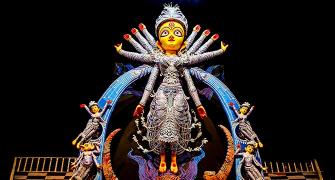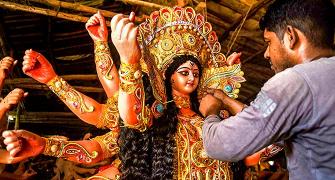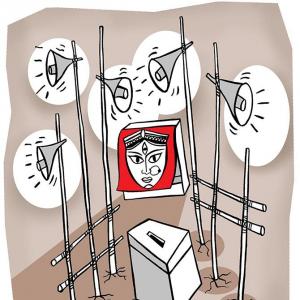If the Puja as a brand can be marketed more effectively outside Bengal, even overseas, it might do wonders for the economy, says Atanu Biswas.

Much scope for evaluations was thrown up when, in 2017, tennis legend Leander Paes, originally from Kolkata, suggested that the grandeur of Durga Puja be marketed globally to make the event as big as the Rio Carnival.
The five-day-long cultural feast called Durga Puja is undoubtedly the biggest street festival in the world. The size of the Durga Puja economy is nearly one-third the annual budget of West Bengal, and is growing rapidly with changing characteristics -- from community worship, through the worship of clubs, we have now moved to the era of sponsors' worship.
In 1954, Economic and Political Weekly published an article entitled 'Economics of the Durga Puja', which described Puja shopping for apparel, shoes, gifts, Puja sales and discounts, street demonstrations for Puja bonus and Puja special periodicals in the backdrop of floods in North Bengal and drought in South Bengal.
Puja sales were described as indicators of the people's economic condition as well as a business barometer.
However, the economics of Durga Puja has changed remarkably in between, with innovative themes, magical enthusiasm, inaugurations by big stars, and competitions over themes, idols, pandals (marquees), lighting, and a lot more.
While Puja shopping and Puja periodicals still dominate Bengalis' lives, their characteristics have changed significantly. More than 10,000 marquees come up in West Bengal every year, nearly 40 per cent of which are in Kolkata, while the numbers of pandals in Mumbai and the NCR are around 140 and 380, respectively.
The expenses for pandals range from a few hundred thousand to tens of millions -- corporate funding and outdoor advertising account for about 90 per cent of the funding. The number of footfalls per day per pandal in Kolkata during the festival is 200,000-300,000.
Assocham had, in a 2013 report, estimated the size of the Durga Puja industry at Rs 250 billion, and projected that it would grow to Rs 400 billion in 2015, at an estimated compound annual growth rate (CAGR) of about 35 per cent.
The Lord Ganesh festival, in contrast, generated business worth about Rs 200 billion across the country, with a 20 per cent CAGR. Accordingly, the size of the Durga Puja economy should be nearly Rs 100,000 crore in 2018, which should be nearly thrice the economy of the Lord Ganesh festival. And West Bengal's projected gross state domestic product in 2018-19 is Rs 10.49 trillion.
During the last few years, the duration of the celebrations and pandal hopping for Durga Puja has been extended to 10-12 days, entailing more business for the entertainment industry, professionals, the industries involved in making idols, pandals, lighting, decoration, food and beverages. However, with the surge in purchases from e-commerce websites in recent years, the dynamics of Puja shopping has already changed remarkably, and this is bound to be redefined in the near future.
Tourism is a much more important component in today's festivity than it was six decades back.
Foreigners flock to Pamplona, the small Spanish town, during its famous San Fermin fiesta in July.
The Munich Oktoberfest, possibly the world's largest folk festival, attracts more than seven million visitors annually, and generates about 1.4 billion euros for Munich.
The Mardi Gras festival in New Orleans attracts millions -- contributing slightly more than 1.5 per cent of the city's GDP.
In the spring, the colour of the yen becomes pink, as the Japanese market Hanami, their Cherry Blossom festival, to the rest of the world.
Rio de Janeiro had more than 1.5 million tourists during the Carnival of 2018, nearly half of them foreigners, and the week-long festivities brought approximately R$3.5 billion (one Brazilian real = Rs 20 as on October 9, 2018) to the city's coffers.
Many people think that the Durga Puja in Kolkata involves much more preparation, effort, colour, enthusiasm, life, splendour, magic, and potential.
Recently, the West Bengal government has started a carnival of selected Puja pandals and idols. The annual cultural extravaganza around Durga Puja in West Bengal during the last few decades itself is a carnival.
I cannot imagine any festival that is more colourful or has better potential for tourism in India.
If the Puja as a brand can be marketed more effectively outside Bengal, even overseas, it might do wonders for the economy. The brand is already developed and enriched over decades -- we just need to sell it appropriately, by proper canvassing and facilitating a more tourist-friendly atmosphere.
Atanu Biswas is Professor of Statistics at the Indian Statistical Institute, Kolkata.










